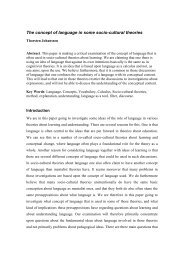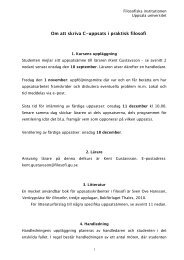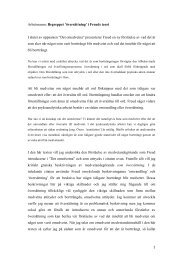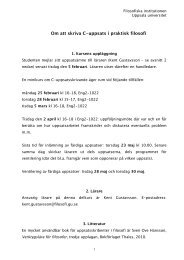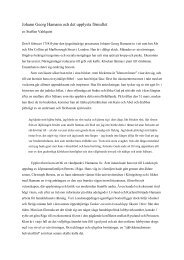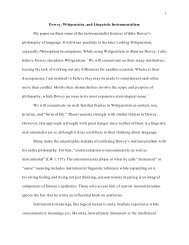Formal Logic, Models, Reality
Formal Logic, Models, Reality
Formal Logic, Models, Reality
You also want an ePaper? Increase the reach of your titles
YUMPU automatically turns print PDFs into web optimized ePapers that Google loves.
3.4 REMARK. If formal logic and formal theories had referred directly to reality, theidea of ontological commitment should have been correct. By Observation 1.3, theyrefer to models and not directly to reality. Therefore belief in a formal theory commitsus to believe in the existence in any model of the theory of objects (sets) representingthe kind of entities quantified over in the theory. Such a belief does not carryany commitment to belief in the existence in reality of the kind of entities quantifiedover in the theory. If we reconsider the false picture 1.1<strong>Formal</strong> logic —————————— <strong>Reality</strong>we see, from the falseness of the picture, that Quine was wrong when he placed ontologicalproblems in the study of the relation between formal theories with formal logicon the one hand and reality on the other. In the correct picture 1.2<strong>Formal</strong> logic ————— Set theoretical model ————— <strong>Reality</strong>ontological problems do not belong to the relation between formal theories with formallogic on the one hand and set theoretical models on the other because existencein such a model does not carry ontological implications. If we want to ask ontologicalquestions, we must either turn directly to reality or study the relation betweensemantic models and reality. This implies that the methodology of ontology is quitesimilar to the one used in classical ontology and has very little resemblance to themethodology proposed by Quine. From the analysis in Remark 2.7, we see that, giventhat we use formal logic and formal theories, the problems of existence and ontologyarise in the relation between model and reality and neither in the relation betweenformal language and model nor in the direct relation between formal languageand reality.3.5 EXAMPLES. (I) Belief in Peano arithmetic PA commits us to belief in the existenceof representatives of the natural numerals 0, 1, 2, … in every set theoreticalmodel of PA. It does not commit us to a belief in the existence of natural numbers,neither in physical reality nor in a Platonic world. If we want to prove the existenceof natural numbers, completely different methods must be used.(II) Belief in the set theory ZF commits us to belief in the existence of representativesof all sets which can be proved to exist in ZF in any model of ZF. It does notcommit us to a belief in the existence of sets, neither in physical reality nor in a Platonicworld.3.6 PROBLEM. Does not every consistent formal theory carry a limited ontologicalcommitment? A set theoretical semantic model is built from sets. Therefore belief ina consistent formal theory seems to commit us to belief in the existence of sets. Sometheories claim the existence of infinite objects. For instance ZF has an axiom which14



